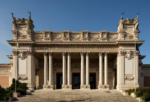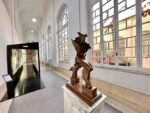Vanessa Billy – The White Goddess
.jpg)
Incroci di ecologia politica e il passaggio dell’energia da un’entità all’altra, visioni distopiche e grumi di materia mitologica: sono questi alcuni dei temi sviluppati dalla pratica di Vanessa Billy (1978, Ginevra) contraddistinta da un forte credo nell’ibridismo e nella capacità di tramutazione degli elementi.
Comunicato stampa
Così a un’ora fissa
Matuta soffonde con la rosea luce dell’aurora
le rive dell’etere e spande la luce…
Lucrezio , De rerum natura (Lib. V, 656-662)
Incroci di ecologia politica e il passaggio dell’energia da un’entità all’altra, visioni distopiche e grumi di materia mitologica: sono questi alcuni dei temi sviluppati dalla pratica di Vanessa Billy (1978, Ginevra) contraddistinta da un forte credo nell’ibridismo e nella capacità di tramutazione degli elementi. Le opere in mostra occupano lo spazio con una presenza tanto corporea quanto vulnerabile, combinano una varietà di forme e sostanze tangibili traducendo le allusioni ad un momento o a un’azione trasformativa che genera l’effetto di ancorarle all’ambiente più prossimo. Assecondando infatti il principio interpretativo dell’analogia, il percorso espositivo si collega idealmente alla Mater Matuta (V sec a.C.) uno dei monumenti più significativi della produzione di statue cinerarie in pietra fetida conservato proprio a Firenze, nel vicino Museo Archeologico. A guisa delle fasi lunari che scandiscono giornalmente il ritmo del tempo, Mater Matuta, con il suo sguardo pervaso da un’intensa malinconia e prolungato oltre la vita terrena, è la dea italica protettrice dell’aurora, della fecondità e della nascita.
Matuta è la “dea bianca” –sorella del miraggio e dell’eco – che, nella sua nudamente indossata magnificenza, ci riporta a quell’istante fuori da ogni durata in cui il mito esplose alla luce per la prima volta. Alla stessa dimensione femminile che da tempo immemorabile è collegata alla luna e che evoca la madre in ogni sua funzione. È quella Dea Bianca che Robert Graves aveva inseguito attraverso tante incarnazioni e metamorfosi. Il corpo della donna offre la medesima visione microcosmica dei ritmi universali della luna, metafora di ciclicità, mutamento, inconscio, segreto, mistero, maternità e fecondità, è simbolo dello scorrere del tempo e rende manifesto il perpetuo ricominciare, la catena ininterrotta di nascite e morti.
Da alba in alba gira la terra e la notte continua a seguire il giorno.
Vanessa Billy (1978, Ginevra, CH) ha studiato al Chelsea College of Art di Londra.
Tra le sue mostre personali più recenti: Future Perfect (2018) a Assembly Point di Londra; Dear Life (2017) al Centre Culturel Suisse di Parigi; We Dissolve (2016) alla Kunsthalle St.Gallen (CH). La sua commissione d’arte pubblica Tränen sarà visibile fino a Marzo 2019 alla St.Peter Church di Zurigo (CH). Tra i suoi prossimi progetti: Konkrete Gegenwart (Febbraio 2019), all’ Haus Konstruktiv, Zurigo (CH); Oil. Beauty and Horror in the Petrol Age (Settembre 2019), al Kunstmuseum Wolfsburg (DE) e al Belvedere Museum, Vienna; una mostra personale (September 2019) alla galleria BolteLang, Zurigo (CH).
Attualmente vive e lavora a Zurigo (CH).
Likewise at a fixed time
Matutan sends abroad the rosy dawn
Through the coasts of heaven, and spreads the light [...]
Lucretius, De rerum natura (Book 5, 656-62)
Amalgamations of political ecology and the passage of energy from one entity to another, dystopian visions and lumps of mythological material: these are some of the themes explored in the practice of Vanessa Billy (1978, Geneva), characterized by a strong belief in hybridism and the capacity of elements for transmutation. The works on display occupy the space with a presence as corporeal as it is vulnerable, combining a variety of tangible forms and substances and translating the allusions to a moment or a transformative action that has the effect of anchoring them to the closest setting. Complying in fact with the interpretative principle of analogy, the layout of the exhibition connects up ideally with the Mater Matuta (5th century BCE), one of the most significant examples of the production of funerary statues in a kind of limestone called pietra fetida which can be seen here in Florence, at the nearby Archaeological Museum. In the guise of the lunar phases that mark the rhythm of time on a daily basis, Mater Matuta, with her expression of intense melancholy and gaze fixed beyond life on this earth, is the Latin goddess of dawn, fertility and birth.
Matuta is the “white goddess” – sister of the mirage and the echo – who, in her nakedly worn magnificence, brings us back to that instant outside any measure of time in which the myth first burst into the light. Into the same female dimension that since time immemorial has been connected with the moon and that evokes the mother in all her roles. She is the White Goddess that Robert Graves had sought in all of her many incarnations and metamorphoses. The woman’s body offers the same microcosmic vision of the universal rhythms of the moon, a metaphor for cyclicity, change, the unconscious, the secret, mystery, maternity and fertility. It is a symbol of the passage of time and makes manifest its perpetual starting over and over again, the uninterrupted chain of births and deaths.
From dawn to dawn the earth turns and night continues to follow day.
Vanessa Billy (1978, Geneva, CH) studied at Chelsea College of Art, London.
Among her recent solo exhibitions: Future Perfect (2018) at Assembly Point, London; Dear Life (2017) at Centre Culturel Suisse, Paris; We Dissolve (2016) at Kunsthalle St.Gallen (CH).Her public art commission Tränen can be seen until March 2019 at St.Peter Church in Zürich (CH).Among her forthcoming projects: Konkrete Gegenwart (February 2019), at Haus Konstruktiv, Zürich, (CH); Oil. Beauty and Horror in the Petrol Age (September 2019), at Kunstmuseum Wolfsburg (DE) and Belvedere Museum, Vienna; solo show (September 2019) at BolteLang, Zürich (CH).
She currently lives and works in Zürich (CH).



